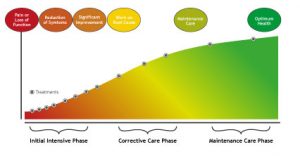Understanding Acupuncture Treatment Frequency
Matthew Fellner, DACM, L.Ac. – Acupuncture Dept. Chair ESATM
May 23, 2019
One of the most frequent questions that people ask about acupuncture, is “how many sessions will I need to get better?” This is completely understandable but also one of the hardest questions to answer definitively. I always tell patients, and potential patients, that managing their health is not an instant fix. Each person is unique, and each condition requires a thorough investigation of the circumstances that caused the disease or imbalance in the first place. Without a detailed examination, even the most skilled doctor can only fathom a guess as to how well any person would respond to treatment.
That is part of the reason why when you come in for an acupuncture session, especially the first time, the practitioner will spend a significant amount of time delving into every aspect of your overall health, not just the specific problem that you are coming in to address. For example, if you come in seeking relief from Migraine headaches, we will explore the details regarding the onset, history, frequency, and contributing factors of that headache. But we will also ask many questions that give us a clearer insight into your overall constitution and how you relate to your total environment. That may include questions about your diet, your emotional wellbeing, your family history, your appetite, sleep habits, bowel habits, menstrual cycle, weather preferences, etc. We’ll feel your pulse, look at your tongue, palpate muscles, look at your face, evaluate your posture, and maybe even do neurological tests. We are trying to develop a picture of your pattern of health & wellness, and how it fits into the expression of symptoms…in this case migraine headaches. Then we are better equipped to come up with a treatment plan that matches exactly what you need.
Imagine for a second you asked me to guess a number that you are thinking of. When I first guess I have no idea what number it could be and I have the entire range of infinite numbers to choose from. But as I keep guessing, you keep saying, “lower”, “higher”, “higher”, etc. until I keep narrowing the range and make it easier to pinpoint what number you were thinking of.
When an acupuncturist treats a patient, he is essentially playing that game, except, instead of trying to guess a number, he is trying to identify what pattern has caused the illness or disease or physical malady. Then, once the pattern has been identified, it also takes time for the treatments to have the desired effect. Again, each condition is different, and each patient unique. But in general, acute conditions of shorter onset, such as muscle strain or tension headache, are easier to identify and also take a much shorter time to treat successfully. Compare that to a chronic condition or more systemic condition like Multiple Sclerosis or spinal disc degeneration. It took a long time for those conditions to manifest in the body, and it will probably take much longer to manage them with acupuncture treatments.
When I sit down with patients, I show them the following chart and I explain that there are generally 3 phases of care. These phases are a guideline that are meant to be general and can be adapted to the level severity that presents in any situation.

1. Initial/Acute Phase – For the first few weeks, the best results come from receiving 2-4 treatments per week. These treatments focus on alleviating symptoms and stimulating a healing response from the body.
2. Corrective Phase– This phase occurs when symptoms have been reduced approx. 50%, or you are able to experience multiple days w/o symptoms. Now the focus of treatment can be adjusting the imbalances that lead to the problem in the first place. 1-2 treatments per week is usually ideal.
3. Maintenance Phase– When you are mainly symptom free, or you are able to resume all normal activity, then the focus of treatment is to ensure that the symptoms don’t come back. Every person will have a different maintenance schedule, but it could be weekly, monthly, or even seasonal.
This way, patients are more informed and have a clearer expectation of how they will proceed through their acupuncture sessions.

